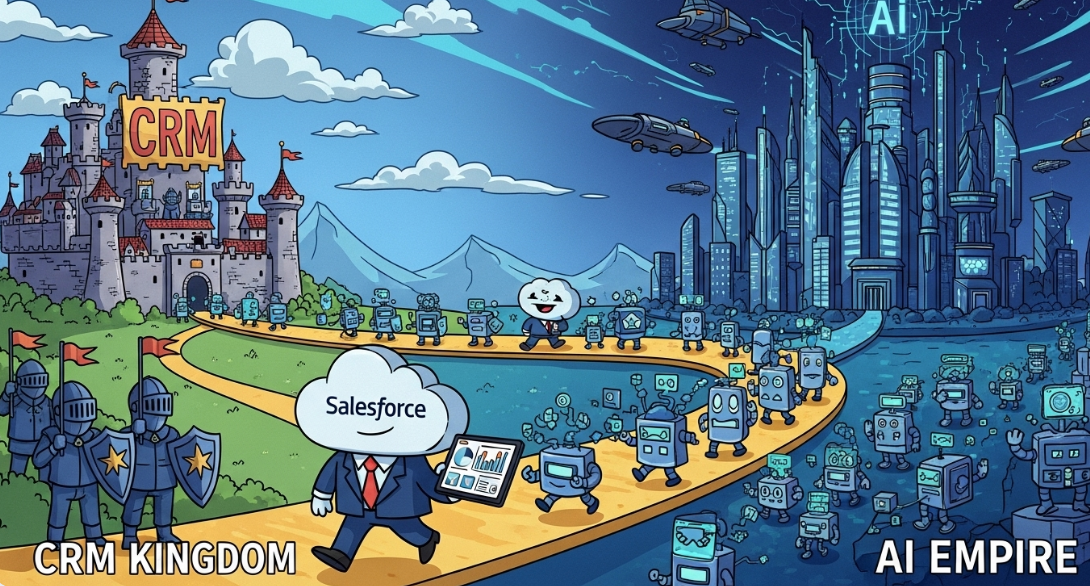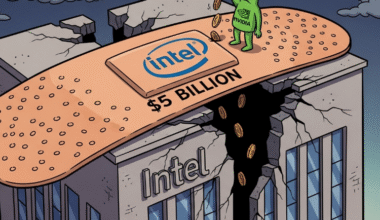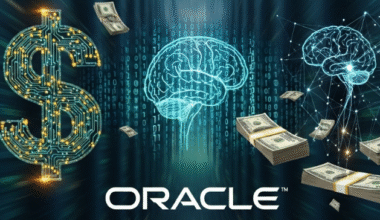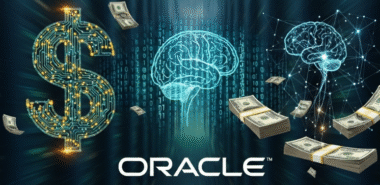Stock Symbol: CRM | Current Price: ~$244 (September 2025) | Target Price: $330+ | Timeframe: 12-18 months
NOT FINANCIAL ADVICE
Salesforce has officially evolved from “that CRM company everyone uses” to “that AI company that happens to dominate customer relationships while building armies of digital agents.” With Q2 2025 revenue hitting $10.24 billion and the revolutionary launch of Agentforce 3.0, Salesforce is proving that Marc Benioff’s vision of the “agentic enterprise” isn’t just corporate buzzword bingo—it’s actually becoming reality. The company delivered $2.91 adjusted EPS (beating $2.78 estimates) while simultaneously deploying over 8,000 customers to their digital labor platform, because apparently helping companies manage relationships wasn’t complicated enough—now they’re automating entire workforces. It’s like watching someone turn a Rolodex into a sentient army of customer service representatives, except the Rolodex is worth $232 billion and the representatives never sleep.
The Agentforce Revolution: From Software to Digital Labor
Salesforce’s Agentforce platform has officially launched Version 3.0, marking the transition from “we have AI features” to “we are the AI workforce infrastructure.” The company is targeting nothing less than empowering one billion agents by the end of 2025, which is either incredibly ambitious or incredibly Benioff, depending on your tolerance for San Francisco-sized dreams.
Since its initial launch in October 2024, Agentforce has helped customers deliver undeniable value, including reducing Engine’s average customer case handle time by 15%, autonomously resolving 70% of 1-800Accountant’s administrative chat engagements during critical tax weeks in 2025, and increasing Grupo Globo’s subscriber retention by 22%. These aren’t pilot program statistics—these are actual business transformations happening right now, proving that AI agents can handle real work better than the humans they’re replacing.
The platform features enhanced reasoning through the Atlas Reasoning Engine, which processes information like humans think and plan, except without coffee breaks or existential crises. Agentforce can take action across every channel and be integrated into any system, making it easy to add agentic automation across your entire business. It’s like having a digital workforce that never calls in sick, never asks for raises, and actually gets smarter over time instead of more cynical.
Financial Performance: The Subscription Machine Keeps Printing
Salesforce’s Q2 2025 results tell the story of a company that knows how to generate recurring revenue, with total revenue of $10.24 billion and adjusted earnings of $2.91 per share, beating estimates on both metrics. Subscription and support revenue hit $9.7 billion, up 11% year-over-year, proving that businesses remain addicted to Salesforce’s CRM ecosystem even while they’re simultaneously trying to replace their employees with AI agents.
Current remaining performance obligation reached $29.4 billion, up 11% year-over-year, which in subscription business terms translates to “we already have billions in future revenue locked in,” the kind of predictable cash flow that makes CFOs weep with joy. The company maintains gross margins around 77%, demonstrating pricing power that would make luxury handbag manufacturers jealous.
Data Cloud revenue grew 120% year-over-year, because apparently Salesforce decided that just managing customer relationships wasn’t enough—they needed to become the foundational data layer for the entire AI economy. It’s like evolving from running a phone book company to owning the entire telecommunications infrastructure, except instead of phone numbers, it’s customer intelligence for autonomous agents.
The AI Transformation: Beyond Copilots to True Autonomy
While competitors build copilots that require human prompting, Agentforce operates autonomously, retrieving data on demand, building action plans, and executing without human intervention. This isn’t incremental improvement—this is categorical transformation from reactive tools to proactive digital workers that handle complex, multi-step business processes.
Agentforce 2dx enables proactive AI agents to work behind the scenes without constant human oversight, anticipating business needs and dynamically taking action. The platform integrates autonomous agents into existing data systems and business logic, creating what Salesforce calls “ambient agents” that operate invisibly in the background of business operations.
The competitive advantage isn’t just technological—it’s architectural. Data Cloud unifies and harmonizes all customer data and metadata across systems in real time, enabling Agentforce to operate with complete context and precision. While competitors scramble to build AI features on top of fragmented systems, Salesforce built a unified platform where agents can access everything they need to make intelligent decisions.
Market Position: The CRM Monopoly Goes Agentic
Salesforce dominates the CRM market with approximately 30% market share in a highly fragmented space that continues growing double digits annually. But the Agentforce platform transforms Salesforce from a software vendor into an infrastructure provider for the agentic economy, expanding their addressable market from CRM software to digital labor across every business function.
The company has announced significant investments, including $6 billion in UK business through 2030 and the launch of Missionforce to power U.S. national security with AI. These aren’t just revenue expansion moves—they’re infrastructure investments that position Salesforce as essential digital backbone for governments and enterprises globally.
The integration of Slack creates an enterprise collaboration platform where human workers and AI agents collaborate seamlessly, making Salesforce not just a system of record but the actual workplace where business gets done. It’s like owning both the office building and the workforce, except the workforce is infinitely scalable and constantly improving.
Execution Risk: Promise vs. Platform Reality
Salesforce’s biggest risk remains execution against aggressive AI adoption timelines while maintaining their core CRM dominance. The company’s stock has been the worst performer in large-cap tech this year, down 23% through the recent earnings report, as investors demand proof that AI investments translate to accelerated growth rather than just higher R&D expenses.
Competition intensifies not just from traditional CRM providers but from AI-native companies building agent platforms from scratch. Salesforce must prove that retrofitting their existing platform with autonomous capabilities creates better outcomes than purpose-built AI systems, while simultaneously educating enterprise customers about the transformational potential of agentic AI.
The enterprise sales cycle creates natural delays between platform capabilities and revenue recognition, as large organizations require extensive pilots and change management to adopt autonomous agent workflows. Success depends on Salesforce’s ability to demonstrate clear ROI from agent deployment while providing sufficient control and transparency for risk-averse enterprise buyers.
The Platform Play: Data, Apps, and Digital Labor
Agentforce is deeply integrated with Salesforce Customer 360, leveraging the full power of applications like sales, service, marketing, and commerce while providing complete customer views for seamless hand-offs between agents and humans. This integration creates switching costs and network effects that compound as organizations deploy more agents across different business functions.
The MuleSoft integration enables Agentforce to connect with any external system, while the Tableau analytics platform provides insights into agent performance and business outcomes. The company estimates 4 trillion flows built annually and 5.6 billion hours saved through automation, demonstrating that customers already trust Salesforce with mission-critical business logic.
Salesforce Ventures’ $500 million Generative AI Fund, including a $200 million investment in Hugging Face, positions the company at the center of the open-source AI ecosystem while creating strategic partnerships that accelerate innovation and market adoption.
Investment Reality Check: The AI Infrastructure Bet
Based on Salesforce’s transformation from CRM vendor to digital labor platform, expanding market opportunity through Agentforce adoption, and sustainable competitive advantages in data integration and enterprise relationships, the company presents a compelling if volatile investment opportunity with a 12-18 month price target of $330+ per share.
Key catalysts include Agentforce customer adoption metrics, expansion beyond current enterprise base into mid-market segments, integration partnerships that extend platform capabilities, and demonstration of measurable ROI from agent deployments. Wall Street analysts maintain a consensus median one-year price target of $342.18, representing 36.78% potential upside, reflecting confidence in the agentic transformation thesis.
The risk-reward profile favors investors who understand that Salesforce isn’t just adding AI features—they’re building the infrastructure for autonomous business operations. The company has successfully navigated multiple technology transitions while maintaining market leadership, suggesting execution capabilities necessary for the agentic transformation.
For investors seeking exposure to the autonomous business revolution through a company with proven platform capabilities, established enterprise relationships, and recurring revenue predictability, Salesforce represents the ultimate enterprise AI infrastructure play. They’ve transformed from managing customer relationships to automating customer interactions, and apparently that’s just the opening act for replacing entire business operations with intelligent agents.
Disclaimer: This analysis contains references to digital labor revolutions and should not be considered personalized investment advice. Past performance does not guarantee future results, though Salesforce’s track record suggests they’re remarkably good at turning enterprise software categories into subscription gold mines. Consult with a qualified financial advisor who hopefully understands both artificial intelligence and Marc Benioff’s relationship with ambitious platform visions.
Last Updated: September 2025
Next Review: December 2025








